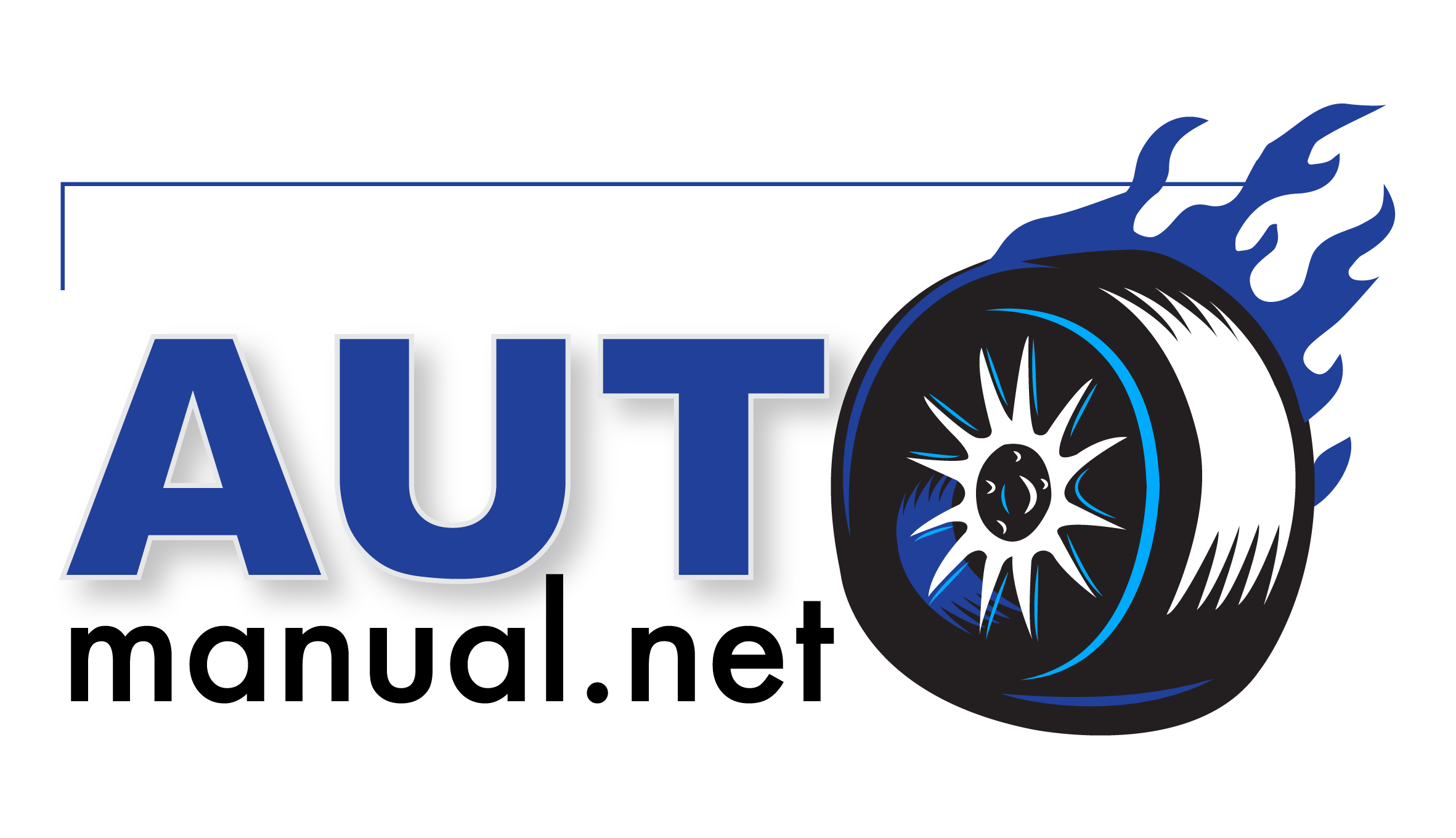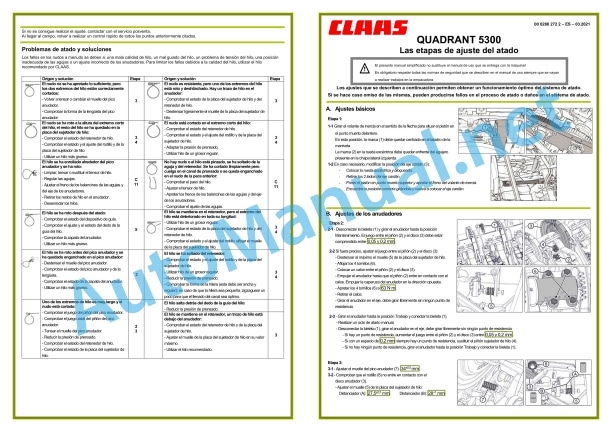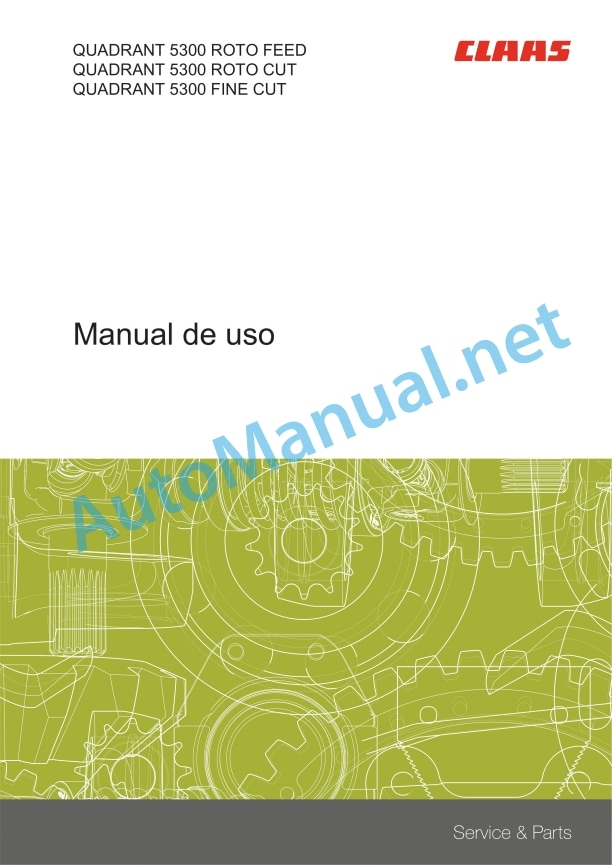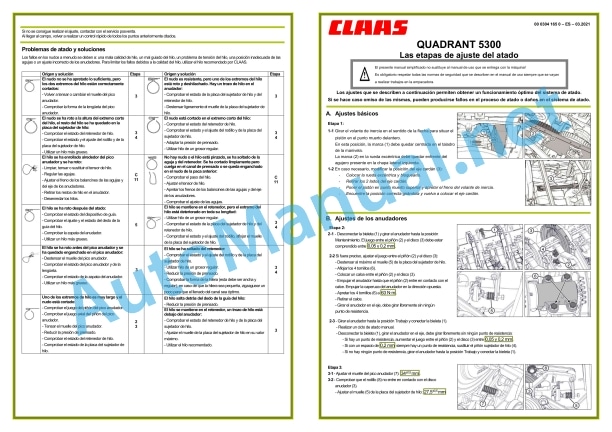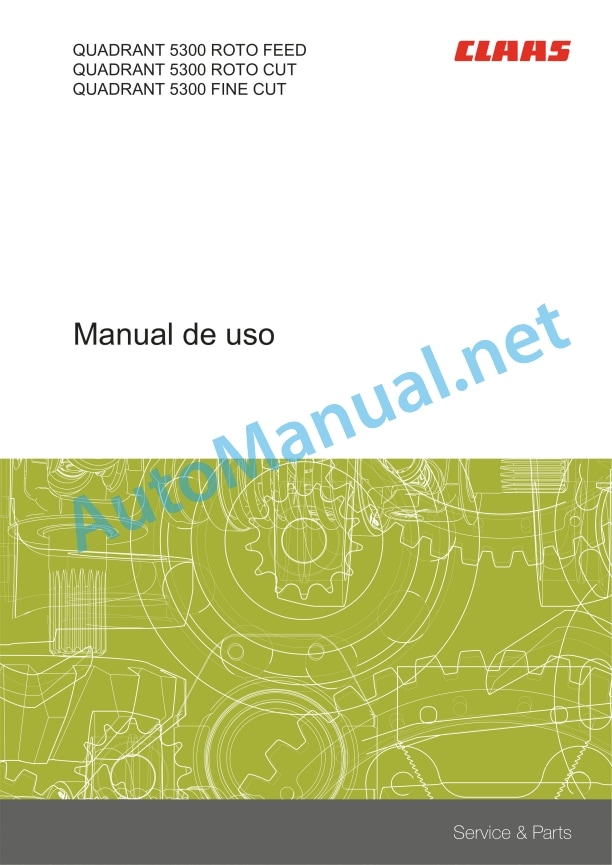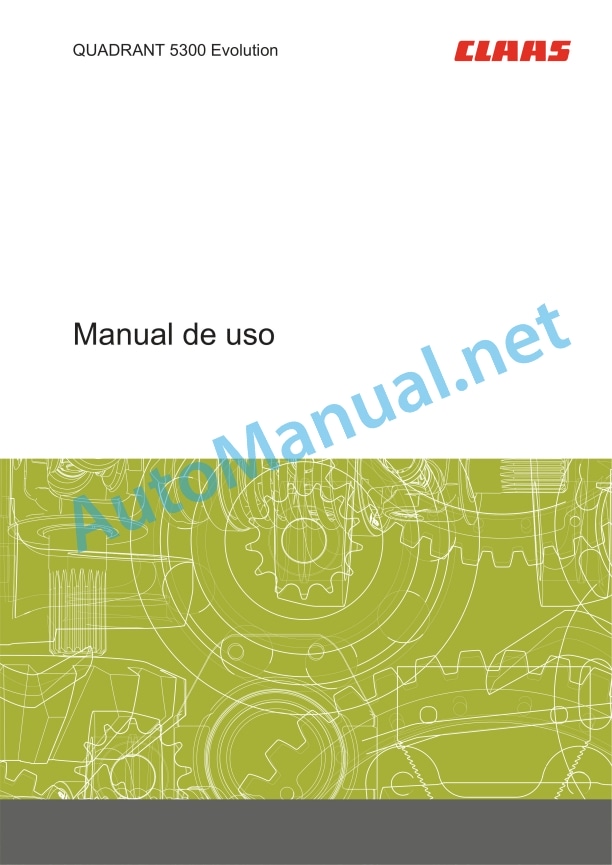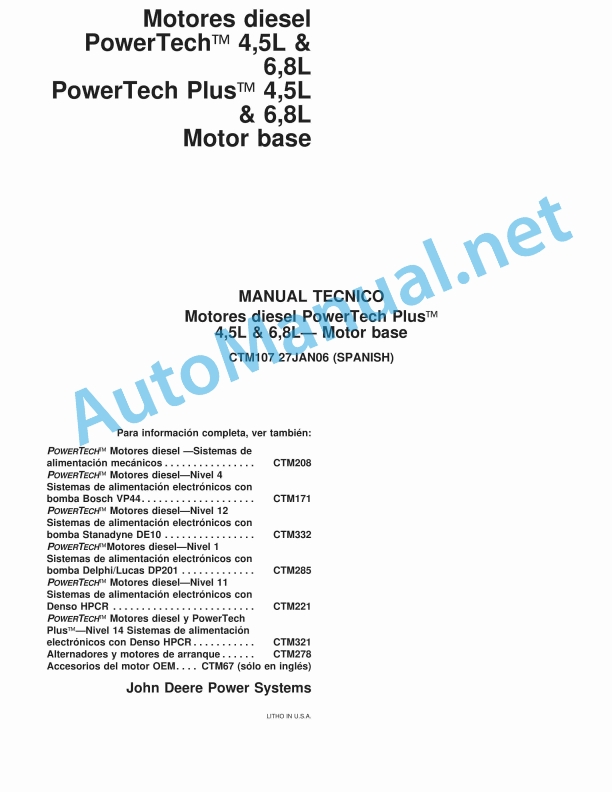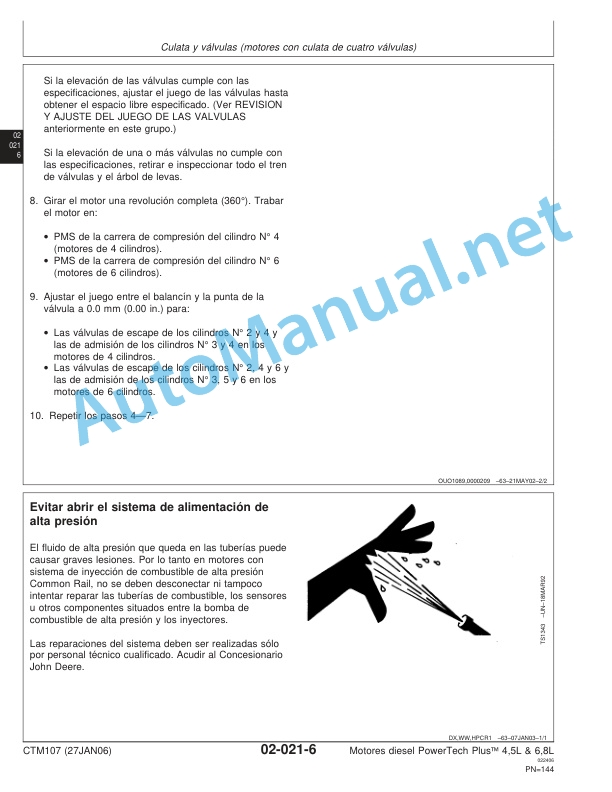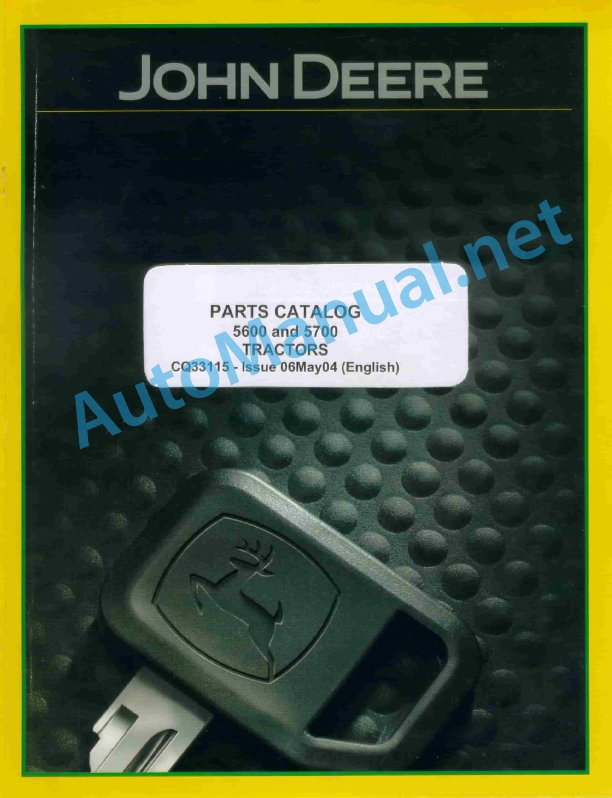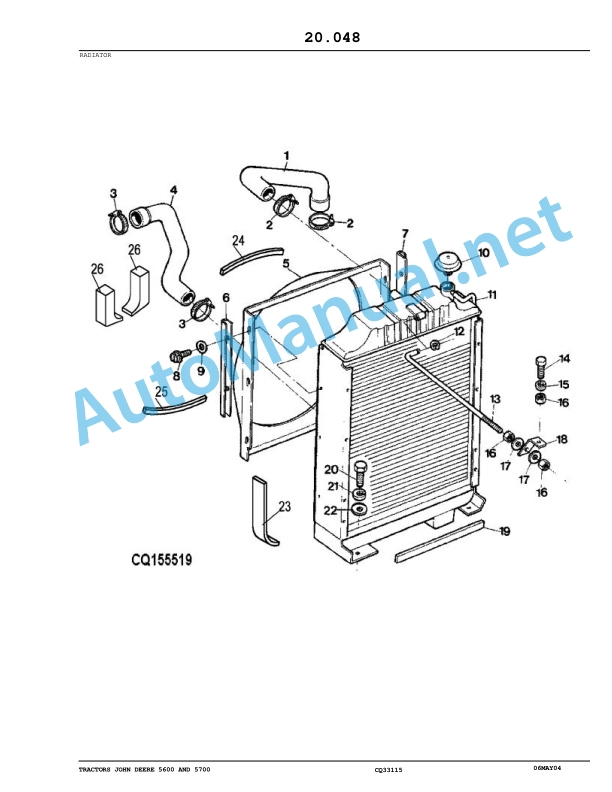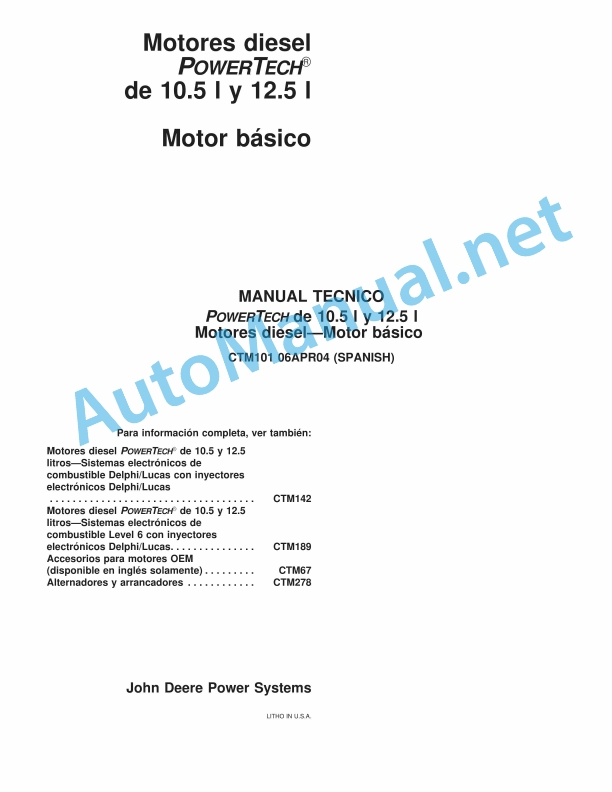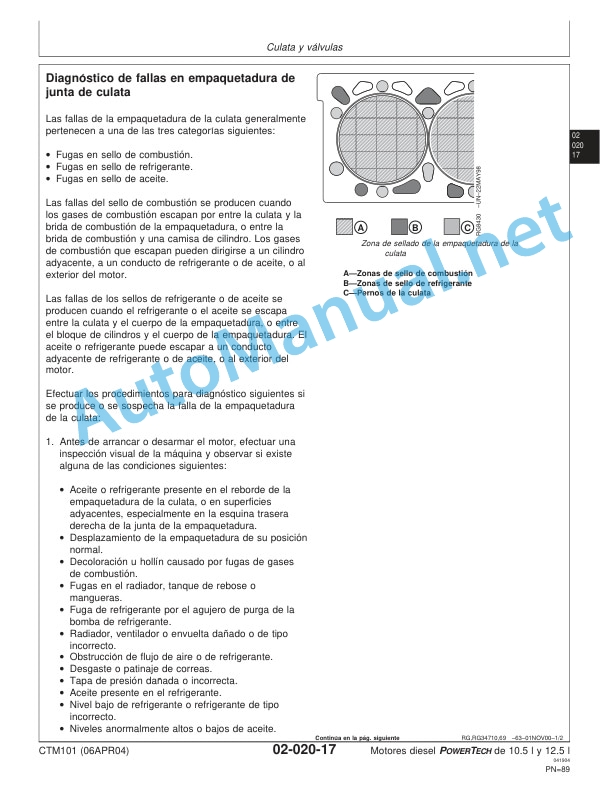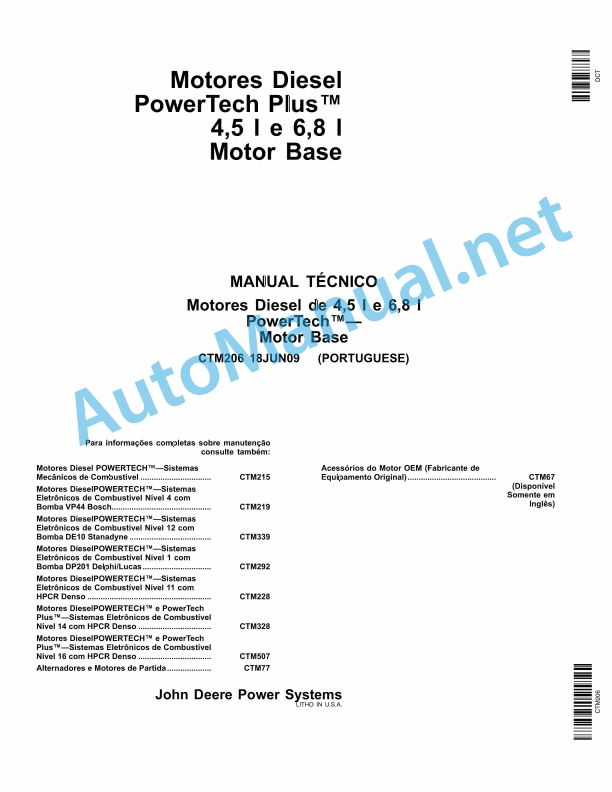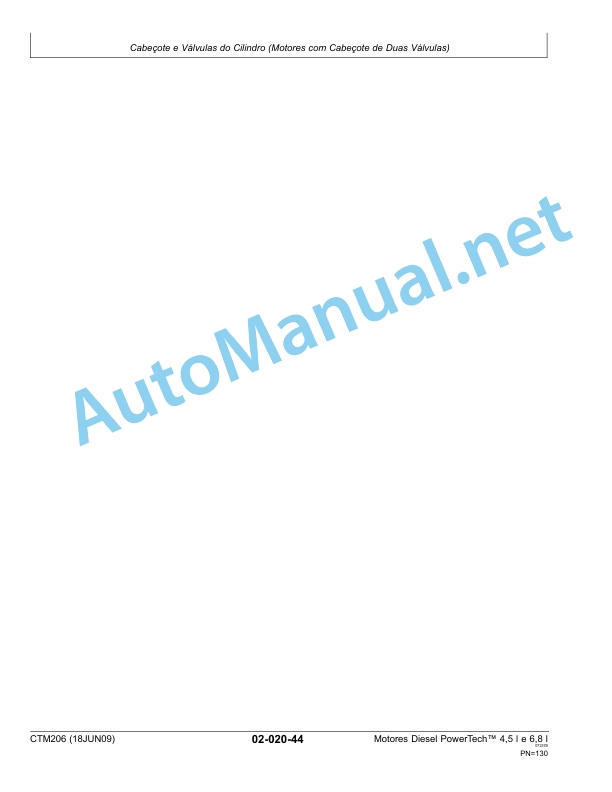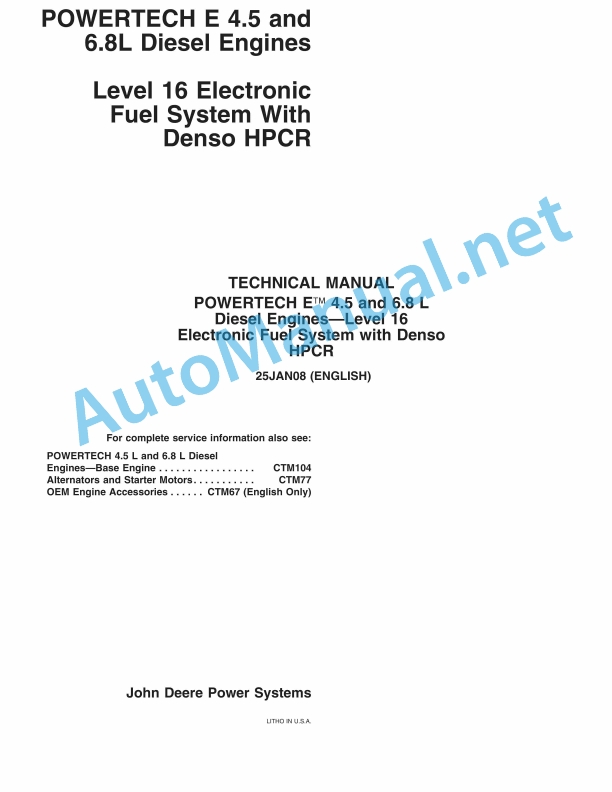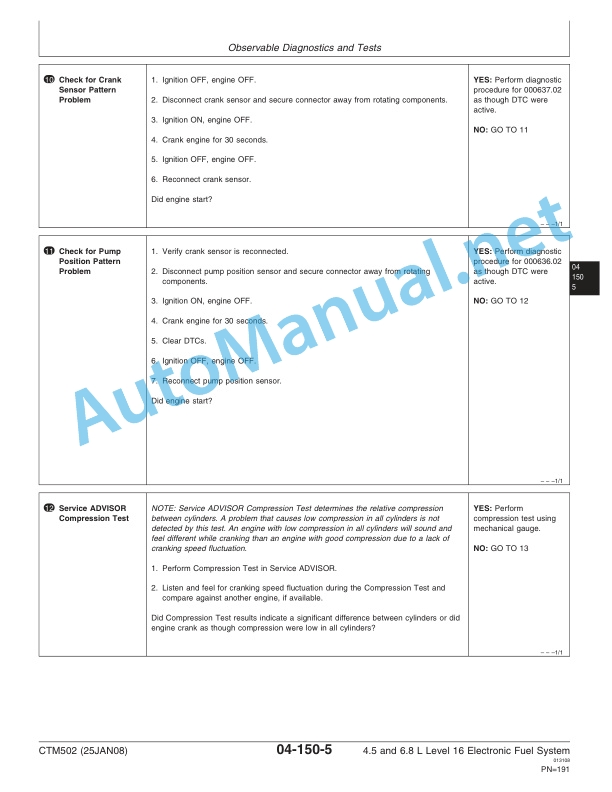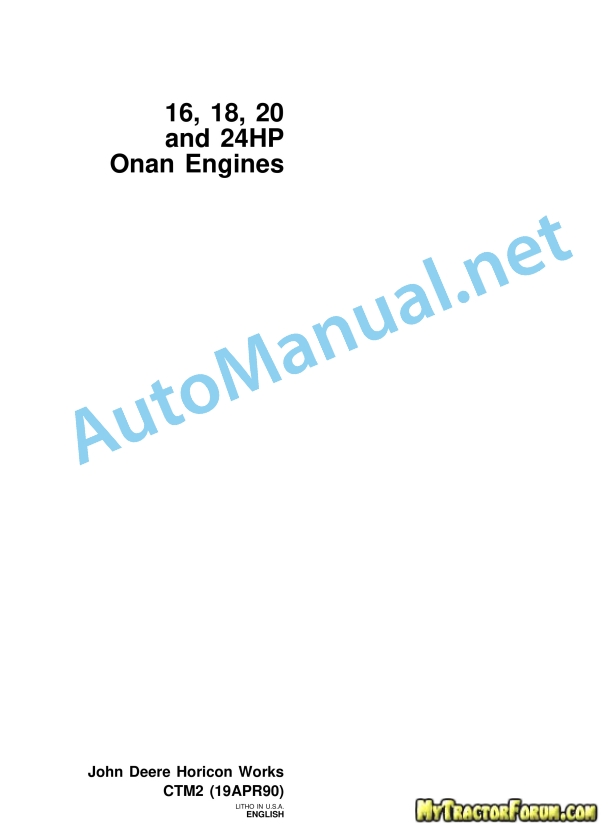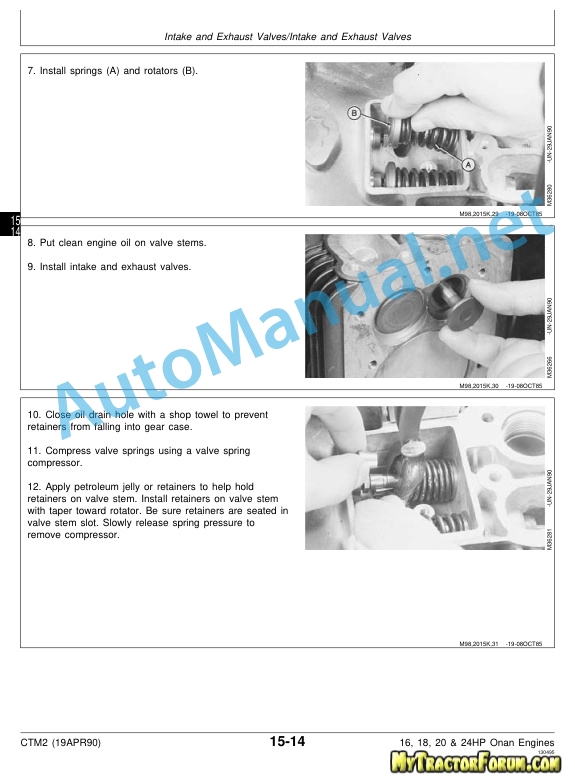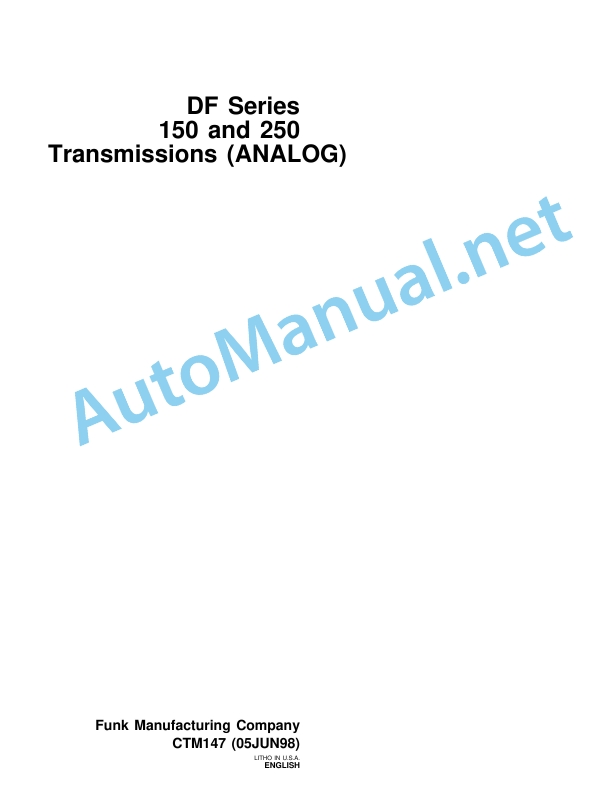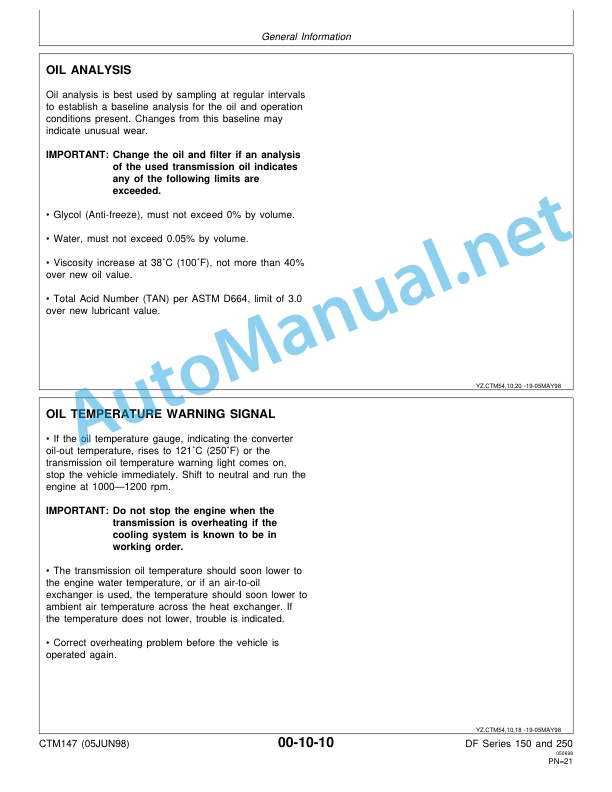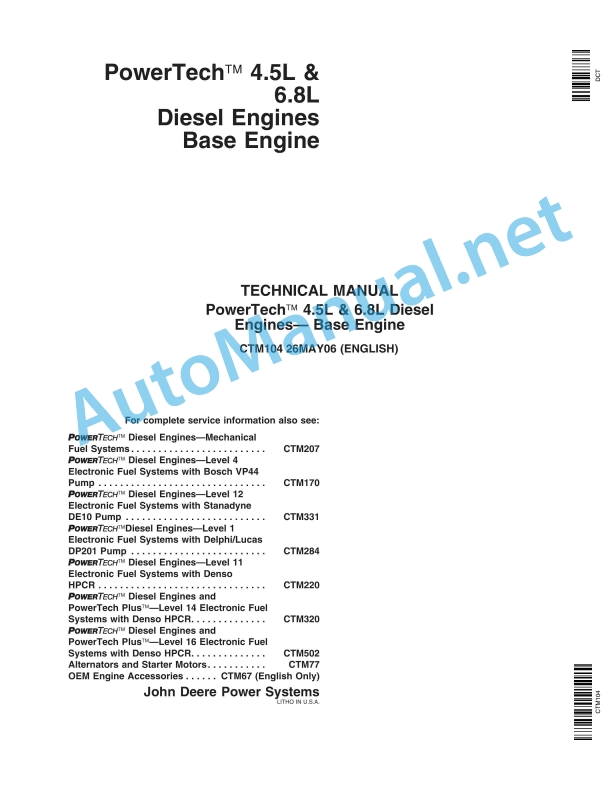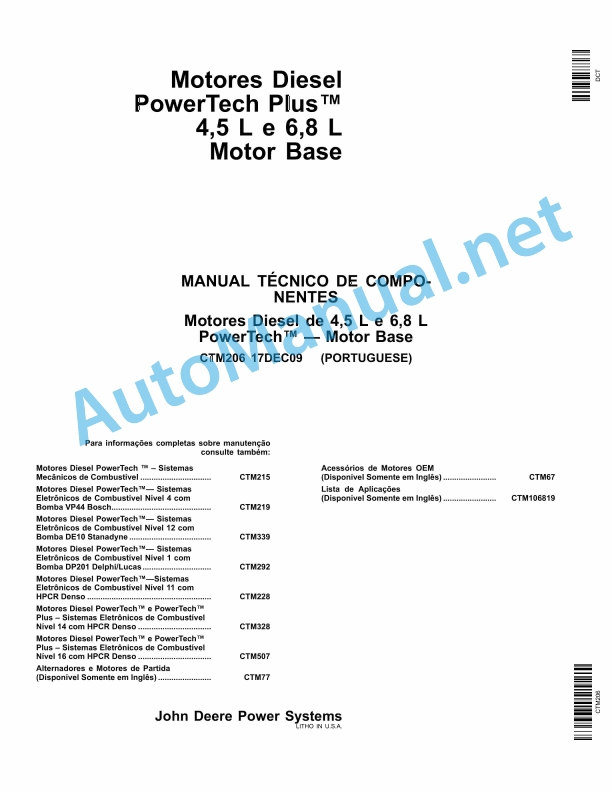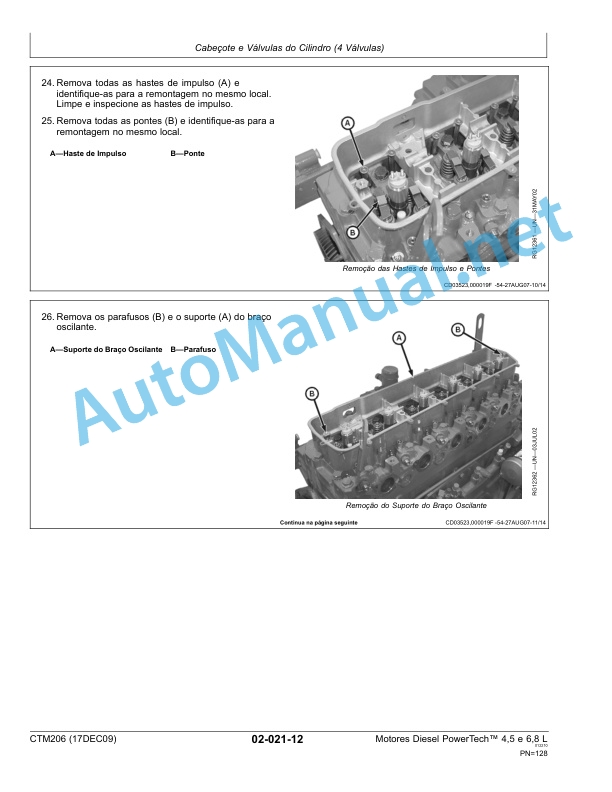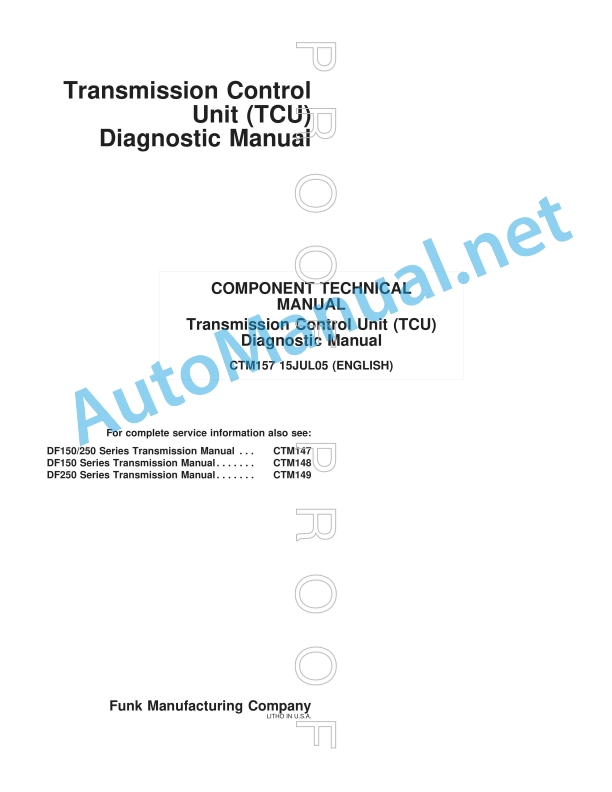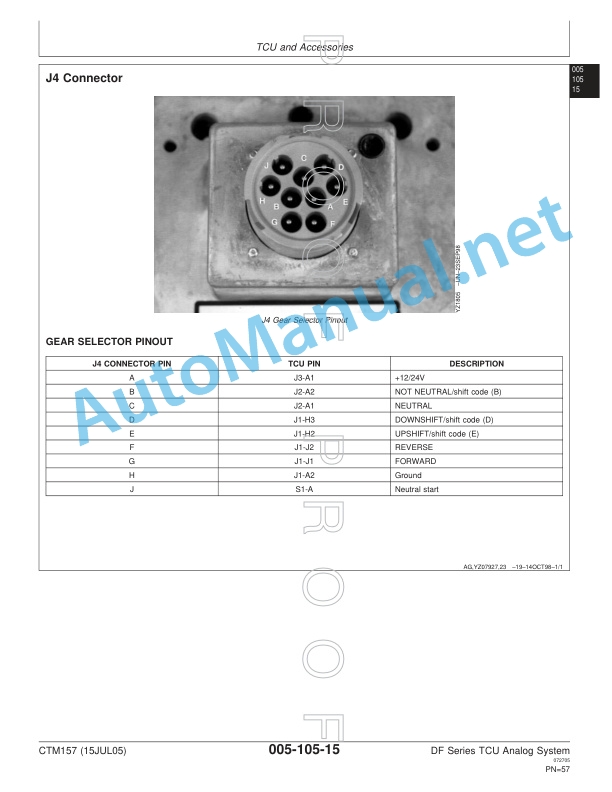Claas Quadrant 5300 (J32) Baler Operator Manual ES
$50.00
- Model: Quadrant 5300 (J32) Baler
- Type Of Manual: Operator Manual
- Language: ES
- Format: PDF(s)
- Size: 156 MB
File List:
00 0288 272 2.pdf
00 0300 211 6.pdf
00 0304 165 0.pdf
00 0304 326 2.pdf
00 0304 326 4.pdf
00 0300 211 6.pdf:
QUADRANT 5300 ROTO FEEDQUADRANT 5300 ROTO CUTQUADRANT 5300 FINE CUT
1. Introduction
1.1 General information
1.1.1 Application of this manual
1.1.2 Information relating to this instruction manual
1.1.3 Symbols and indications
1.1.4 Optional equipment
1.1.5 Qualified specialized workshop
1.1.6 Maintenance instructions
1.1.7 Information regarding warranty
1.1.8 Spare parts and technical issues
1.2 Proper application of the machine
1.2.1 Authorized use
1.2.2 Reasonably foreseeable misuse
2 Security
2.1 Recognize warning signs
2.1.1 Danger symbols
2.1.2 Keyword
2.2 Safety instructions
2.2.1 Meaning of the instruction manual
2.2.2 Observe graphic danger symbols and alarm indications
2.2.3 Requirements for all people working with the machine
2.2.4 Children in danger
2.2.5 Danger zones
2.2.6 Position yourself between the tractor and the machine
2.2.7 Accompanying persons
2.2.8 Couple the tractor with the machine
2.2.9 Risk of injury due to rotating shafts
2.2.10 Construction changes
2.2.11 Optional equipment and spare parts
2.2.12 Control of the tractor in operation
2.2.13 Use only after correct start-up
2.2.14 Technical status
2.2.15 Danger due to machine breakdowns
2.2.16 Comply with technical limit values
2.2.17 Danger due to coasting parts
2.2.18 Keep protective devices operational
2.2.19 Personal protective equipment
2.2.20 Wear appropriate clothing
2.2.21 Remove dirt and loose objects
2.2.22 Prepare the machine for road traffic
2.2.23 Dangers when driving on the road and in the countryside
2.2.24 Park the machine safely
2.2.25 Parking without supervision
2.2.26 Consumables that do not meet the requirements
2.2.27 Safe handling of consumables and auxiliary materials
2.2.28 Environmental protection and waste disposal
2.2.29 Fire protection
2.2.30 Deadly electrical discharge through overhead lines
2.2.31 Electrical shock from electrical equipment
2.2.32 Liquids under pressure
2.2.33 Pressurized air
2.2.34 Hot surfaces
2.2.35 Work only on the stopped machine
2.2.36 Maintenance work and repair work
2.2.37 Machine parts and lifted loads
2.2.38 Risks derived from welding work
2.3 Graphic danger symbols
2.3.1 Structure of graphic hazard symbols
2.3.2 Location of safety stickers
3 Machine Description
3.1 Existing models
3.1.1 Designation of machines
3.2 Overview and functions
3.2.1 Left side
3.2.2 Right side
3.3 Safety equipment
3.3.1 Signal lighting
3.3.2 Reflective equipment
Clearance reflectors
3.3.3 Surety
3.3.4 Shims
3.3.5 Parking brake
3.3.6 Flywheel brake
3.3.7 Hydraulic flywheel brake*
3.3.8 Locking the pick-up
3.3.9 Locking the bale unloading ramp
3.3.10 Rotating flashing light
3.3.11 Fire extinguisher*
3.4 Work and service positions
3.4.1 General information
3.4.2 Front of the baler
3.4.3 Top of the baler
3.5 Identification plate and serial number
3.5.1 Spare parts and technical information
3.5.2 Serial number, identification number or VIN code
3.5.3 Identification plate
Identification plate (A)
Identification plate (B)
3.5.4 Rudder identification plate*
3.5.5 Colaert axle identification plate
3.6 General operating principle
3.6.1 Bale pressing cycle
3.7 Machine information
3.7.1 Location of information stickers
3.8 Control terminal
3.8.1 CEMIS 700*
3.8.2 ISOBUS connection
3.8.3 EASY on board
3.9 Transmission and drive
3.9.1 Power transmission
3.9.2 Friction clutch
3.9.3 Main drive
3.9.4 Rotor drive
3.9.5 Carrier drive
3.9.6 Knotter operation
3.10 Axis
3.10.1 General information
3.10.2 Single axis
3.10.3 Tandem axle
3.10.4 Tracking tandem axle
3.11 Service brake
3.11.1 General information
3.11.2 Pneumatic braking
3.11.3 Hydraulic braking
3.11.4 Active hydraulic braking
3.12 Trailer support
3.12.1 Types of coupling
3.13 Hydraulic system
3.13.1 Hydraulic oil tank
3.13.2 Load Sensing*
3.14 Harvest harvest
3.14.1 Pick-up
3.14.2 Reducing rollers
3.15 Power supply unit
3.15.1 Rotor
3.15.2 Cutting device*
ROTO CUT*
FINE CUT*
ROTO CUT blades
FINE CUT blades
Cutting bottom with slide
Protection against foreign bodies
False blades
False blade holder
3.15.3 Cutting device control console*
3.15.4 Pre-chamber
3.15.5 Carrier
3.16 Pressing system
3.16.1 Piston and pressing channel
Hydraulic pressure accumulators
Pressing channel hydraulic pressure accumulator
Hydraulic pressure compensation accumulators
3.16.2 Regulation of pressing pressure
3.16.3 Corn kit*
3.17 Tying system
3.17.1 Tying process
3.17.2 Thread boxes
3.17.3 Thread shortage indicator
3.17.4 Needles
3.17.5 Knotters
3.17.6 Turbofan
3.18 Unloading bales
3.18.1 2-way key
3.18.2 Bale unloading ramp
3.18.3 Bale unloading ramp position detector
3.18.4 Bale unloading sensor*
3.18.5 Humidity sensor*
3.18.6 Bale weighing device*
3.18.7 Bale ejector
3.19 Centralized lubrication
3.19.1 Automatic centralized lubrication
3.19.2 Automatic chain lubrication*
3.20 Equipment
3.20.1 Ladder
3.20.2 Front ladder support
3.20.3 Storage cabinet*
3.20.4 Work lighting*
3.20.5 Electronic module and diagnostic socket
3.20.6 12 V socket
3.20.7 Anti-theft*
4 Control and display instruments
4.1 CEMIS 700
4.1.1 Presentation
4.1.2 Description of the CEMIS 700
00 0304 326 2.pdf:
QUADRANT 5300 ROTO FEEDQUADRANT 5300 ROTO CUTQUADRANT 5300 FINE CUT
1. Introduction
1.1 General information
1.1.1 Application of this manual
1.1.2 Information relating to this instruction manual
1.1.3 Symbols and indications
1.1.4 Optional equipment
1.1.5 Qualified specialized workshop
1.1.6 Maintenance instructions
1.1.7 Information regarding warranty
1.1.8 Spare parts and technical issues
1.2 Proper application of the machine
1.2.1 Authorized use
1.2.2 Reasonably foreseeable misuse
2 Security
2.1 Recognize warning signs
2.1.1 Danger symbols
2.1.2 Keyword
2.2 Safety instructions
2.2.1 Meaning of the instruction manual
2.2.2 Observe graphic danger symbols and alarm indications
2.2.3 Requirements for all people working with the machine
2.2.4 Children in danger
2.2.5 Danger zones
2.2.6 Position yourself between the tractor and the machine
2.2.7 Accompanying persons
2.2.8 Couple the tractor with the machine
2.2.9 Risk of injury due to rotating shafts
2.2.10 Construction modifications
2.2.11 Optional equipment and spare parts
2.2.12 Control of the tractor in operation
2.2.13 Use only after correct start-up
2.2.14 Technical status
2.2.15 Danger due to machine breakdowns
2.2.16 Comply with technical limit values
2.2.17 Danger due to coasting parts
2.2.18 Maintain functional protection devices
2.2.19 Personal protective equipment
2.2.20 Wear appropriate clothing
2.2.21 Remove dirt and loose objects
2.2.22 Prepare the machine for road traffic
2.2.23 Dangers when driving on the road and in the countryside
2.2.24 Park the machine safely
2.2.25 Parking without supervision
2.2.26 Consumables that do not meet the requirements
2.2.27 Safe handling of consumables and auxiliary materials
2.2.28 Environmental protection and waste disposal
2.2.29 Fire protection
2.2.30 Deadly electrical discharge through overhead lines
2.2.31 Electrical shock from electrical equipment
2.2.32 Liquids under pressure
2.2.33 Pressurized air
2.2.34 Hot surfaces
2.2.35 Work only on the stopped machine
2.2.36 Maintenance work and repair work
2.2.37 Machine parts and lifted loads
2.2.38 Risks derived from welding work
2.3 Graphic danger symbols
2.3.1 Structure of graphic hazard symbols
2.3.2 Location of safety stickers
3 Machine Description
3.1 Existing models
3.1.1 Designation of machines
3.2 Overview and functions
3.2.1 Left side
3.2.2 Right side
3.3 Safety equipment
3.3.1 Signal lighting
3.3.2 Reflective equipment
Clearance reflectors
3.3.3 Surety
3.3.4 Shims
3.3.5 Parking brake
3.3.6 Flywheel brake
3.3.7 Hydraulic flywheel brake*
3.3.8 Locking the pick-up
3.3.9 Locking the bale unloading ramp
3.3.10 Rotating flashing light
3.3.11 Fire extinguisher*
3.4 Work and service positions
3.4.1 General information
3.4.2 Front of the baler
3.4.3 Top of the baler
3.5 Identification plate and serial number
3.5.1 Spare parts and technical information
3.5.2 Serial number, identification number or VIN code
3.5.3 Machine identification plate
Identification plate for machines with European approval
Identification plate for machines without European approval
Identification plate for the countries of the Customs Union (Belarus, Kazakhstan, Russia)
3.5.4 Colaert axle identification plate
3.6 General operating principle
3.6.1 Bale pressing cycle
3.7 Machine information
3.7.1 Location of information stickers
3.8 Control terminal
3.8.1 CEMIS 700*
3.8.2 ISOBUS connection
3.8.3 EASY on board
3.9 Transmission and drive
3.9.1 Power transmission
3.9.2 Friction clutch
3.9.3 Mechanical overload safety
3.9.4 Main drive
3.9.5 Rotor drive
3.9.6 Carrier drive
3.9.7 Knotter operation
3.10 Axis
3.10.1 General information
3.10.2 Single axis
3.10.3 Tandem axle
3.10.4 Tracking tandem axle
3.11 Service brake
3.11.1 General information
3.11.2 Pneumatic braking
3.11.3 Hydraulic braking
3.11.4 Active hydraulic braking
3.12 Trailer support
3.12.1 Types of coupling
3.13 Hydraulic system
3.13.1 Hydraulic oil tank
3.13.2 Load Sensing*
3.14 Harvest harvest
3.14.1 Pick-up
3.14.2 Reducing rollers
3.15 Power supply unit
3.15.1 Rotor
3.15.2 Cutting device*
ROTO CUT*
FINE CUT*
ROTO CUT blades
FINE CUT blades
Cutting bottom with slide
Protection against foreign bodies
False blades
False blade holder
3.15.3 Cutting device control console*
3.15.4 Pre-chamber
3.15.5 Carrier
3.16 Pressing system
3.16.1 Piston and pressing channel
Hydraulic pressure accumulators
Pressing channel hydraulic pressure accumulator
Hydraulic pressure compensation accumulator
3.16.2 Raceway Blades
3.16.3 Pressing pressure regulation
3.16.4 Corn kit*
3.16.5 Heavy Duty Kits (HD)*
3.17 Tying system
3.17.1 Tying process
3.17.2 Thread boxes
3.17.3 Thread shortage indicator
3.17.4 Needles
3.17.5 Knotters
3.17.6 Turbofan
3.18 Unloading bales
3.18.1 Bale unloading ramp
Control of the hydraulic bale unloading ramp from the cabin
3.18.2 Bale unloading ramp position detector
3.18.3 Bale unloading sensor*
3.18.4 Humidity sensor*
3.18.5 Bale weighing device*
3.18.6 Bale ejector
Control of the bale ejector from the cabin
3.19 Centralized lubrication
3.19.1 Automatic centralized lubrication
3.19.2 Automatic chain lubrication*
3.20 Equipment
3.20.1 Ladder
3.20.2 Front ladder support
3.20.3 Storage cabinet*
3.20.4 Work lighting*
3.20.5 Camera*
3.20.6 Electronic module and diagnostic socket
3.20.7 12 V socket
3.20.8 Anti-theft*
3.20.9 Water tank
3.20.10 Special tool
Tying trigger tool
4 Control and display instruments
4.1 CEMIS 700
4.1.1 Presentation
4.1.2 Description of the CEMIS 700
4.1.3 Description of the CEMIS 700
4.1.4 Description of the CEMIS 700
4.1.5 Description of the
4.1.6 Description of the
4.1.7 Description of the
4.1.8 Description of the CEMIS 700
4.1.9 Description of the CEMIS 700
4.1.10 Description of the CEMIS 700
4.1.11 Description of the CEMIS 700
4.1.12 Description of the CEMIS 700
4.1.13 Description of the CEMIS 700
4.2 ISOBUS terminal
4.2.1 Presentation
4.2.2 General information
4.3 EASY on board
4.3.1 Presentation
4.3.2 General information
5 Technical data
5.1 Baler
5.1.1 Dimensions
5.1.2 Weight
Baler with European approval
Baler with national approval – FRANCE
Baler with national approval – Outside FRANCE
5.1.3 Hookup
5.1.4 Cardan shaft
5.1.5 Pick-up
5.1.6 Power group
5.1.7 Pressing system
5.1.8 Unloading bales
5.1.9 Tying device
5.1.10 Wheels
5.1.11 Braking
5.1.12 Speed - Brake Type / Axle
5.1.13 Hydraulic circuit
5.1.14 Screw tightening torques
5.1.15 Greasing and lubrication
5.1.16 Sound levels
5.2 Safety devices
5.2.1 Security screw
5.2.2 Overload safety
5.3 Inputs
5.3.1 Lubricants
5.3.2 Threads
5.4 Tractor
5.4.1 Required power
5.4.2 Maximum authorized mass of the towing vehicle
5.4.3 PTO
5.4.4 Hooking
5.4.5 Electrical connectio 5.4.6 Hydraulic connections
5.4.7 Hydraulic circuit and oil
5.4.8 Braking
6paration of the machine
6.1 Turn off the machine and secure it
6.1.1 Stop and secure the tractor and machine
6.2 Adapt the tractor
6.2.1 Check the tractor power take-off protection device
6.2.2 Adapt the tractor’s pneumatic brake equipment
6.2.3 CEMIS 700* assembly
6.2.4 Battery cable*
6.2.5 Battery cable* – Non-ISOBUS tractor
6.3 Adapt the machine
6.3.1 Cardan shaft safety regulations
6.3.2 Cardan shaft coupling
6.3.3 Adaptation of the cardan shaft length
6.3.4 Double-joint wide-angle gimbal
6.3.5 Adaptation of the hitch to the fork / hitch to the oscillating bar
6.4 Hooking up the machine
6.4.1 Recommendations
6.4.2 Hitching the baler to the tractor
6.4.3 Positioning the cardan shaft
6.4.4 Connection of hydraulic hoses
Hose identification
Identification of the hydraulic system present on the tractor
General hydraulic system of the baler equipped with ROTO FEED and tractor equipped with a
Tractor equipped with a
Tractor equipped with constant flow hydraulic system and Tractor equipped with
Tractor with constant pressure hydraulic system
Sear and pick-up
Tracking tandem axle*
Hydraulic flywheel brake*
6.4.5 Connection of brake hoses
Hose identification
Hydraulic brake*
Active hydraulic brake*
Air brake*
6.4.6 Connection of electrical cables
Identification of electrical cables
Standard equipment
Power supply to the baler and CEMIS 700*
Available sockets on the power cord
Baler side
CEMIS 700
tractor side
Baler power supply with ISOBUS cable*
Available sockets on the power cord
Baler side
tractor side
6.4.7 Lighting connection
6.4.8 Connect the camera*
6.5 Prepare for use at work
6.5.1 Important
6.5.2 Pick-up wheels
6.5.3 Pick-up height
Pick-up height depending on the material collected
6.5.4 Reduction rollers – Front roller position
6.5.5 Mechanical reduction rollers – Working height
6.5.6 Removable through-screw tines*
6.6 Tied
6.6.1 Thread selection
6.6.2 Preparation
Thread box
6.6.3 Thread tension adjustment
6.6.4 Thread placement
6.6.5 Placing the thread in the knotters
6.6.6 Checking the settings
6.7 Cutting device
6.7.1 Safety regulations
6.7.2 Control
6.7.3 Placing the blades
6.7.4 Placing the false blades*
6.7.5 Unused blades and false blades
6.8 Bale weighing device
6.8.1 Bale weighing device*
6.9 Load the machine
6.9.1 Lifting the baler
6.9.2 Baler stowage
7 Management
7.1 General information
7.1.1 Baler user
7.1.2 Opening of hatches and crankcases
7.2 Movements with the baler
7.2.1 Equipment control
7.2.2 Preparations for transportation
7.2.3 Road travel
7.2.4 Arrival at the field
7.2.5 Moving around the field
7.2.6 Parking
7.3 Before each use
7.3.1 Reminders
7.3.2 Cardan shaft
7.3.3 Baler maintenance
7.4 Commissioning in the field
7.4.1 Usage tips
7.4.2 Commissioning of the machine
cardan shaft
Material transfer system
After a machine stop
7.4.3 Hydraulic flywheel brake*
7.4.4 Bale unloading ramp
Manual bale unloading ramp
Hydraulic bale unloading ramp
Control of the bale unloading ramp from the cabin*
7.4.5 Bale ejector
7.4.6 Tracking tandem axle*
7.5 Cutting device
7.5.1 Cutting device control console*
Using automatic mode
Lower the cutting frame to the blade change position
Raise the cutting frame to the working position
Automatic cycle interruption
Using manual mode
Activate the blades
Deactivate the blades
Raise the cutting frame
Lower the cutting frame
7.6 Bale parameters
7.6.1 Bale adjustments
7.7 CEMIS 700
7.7.1 Display and navigation
7.7.2 Using the virtual keyboard
7.7.3 Pressing process
7.7.4 Pressing pressure
7.7.5 Automatic regulation of pressing pressure*
Bale density adjustment
Setting with function keys
Adjustment with the wheel
Setting with the virtual keyboard
Measured pressure
Measured pressure: Particular case
Activation of pressing pressure
Calibration of automatic pressing pressure regulation
7.7.6 Bale length
7.7.7 Pre-chamber retention force
7.7.8 Cutting device*
7.7.9 Automatic blade cleaning*
7.7.10 Folding bottom
7.7.11 Pressing channel filling indicator*
7.7.12 Humidity indicator*
7.7.13 Manual triggering of the tying process
7.7.14 Weighing*
7.7.15 Work lighting*
7.7.16 Automatic lubrication
7.7.17 Choosing the task
7.7.18 Task name
7.7.19 Setting name
7.7.20
7.7.21 Counters
7.7.22 Print customer or task data
7.7.23 Maintenance indicator
7.7.24 Control of the bale unloading ramp*
7.7.25 Bale ejector control*
7.7.26 Faults
7.7.27 DTC faults
7.7.28 Faults
7.7.29 TELEMATICS on Implement
7.7.30 Task Management*
7.8 Unclogging the baler
7.8.1 How to avoid traffic jams?
7.8.2 Safety regulations
7.8.3 Pick-up jam
7.8.4 Jam of the reduction rollers
7.8.5 Feed rotor jam*
Rotor unclogging
Manual rotor unclogging
7.8.6 Cutting rotor jamming*
Mechanical unclogging of the rotor
Manual rotor unclogging
7.9 After use
7.9.1 Reminders
7.9.2 Immobilization of the baler
7.9.3 Daily checks
7.9.4 Daily cleaning
7.10 Unhook the machine
7.10.1 Disconnecting the baler
8 Incident and solution
8.1 Tied
8.1.1 Origin of tying problems
8.1.2 Resolution of tying problems
8.2 Centralized lubrication
8.2.1 Resolution of centralized lubrication problems
8.3 Control terminal
8.3.1 Faults displayed on the control terminal
8.3.2 Main drive and system
8.3.3 Transfer system
8.3.4 Hydraulic system
8.3.5 Bale unloading ramp
8.3.6 Bale weighing device
8.3.7 Lack of thread
8.3.8 Automatic regulation of pressing pressure*
8.3.9 Chain lubrication system
8.3.10 Monitoring of knotters*
8.3.11 Tying failures
8.4 Electrical and electronic system
8.4.1 Electrical circuit faults
9 Maintenance
9.1 General maintenance instructions
9.1.1 Maintenance and safety tips
9.1.2 Wheels and tires
9.1.3 Brakes
9.1.4 Hydraulic circuit
9.1.5 Chains
9.1.6 Cardan shaft
9.1.7 Inductive sensors
9.2 Maintenance tables
9.2.1 After the first 10 hours of service
9.2.2 After the first 50 hours of service
9.2.3 Every 10 hours of service or daily
9.2.4 Every 50 hours of service
John Deere Repair Technical Manual PDF
John Deere Repair Technical Manual PDF
John Deere Repair Technical Manual PDF
John Deere Repair Technical Manual PDF
John Deere POWERTECH E 4.5 and 6.8 L Diesel Engines TECHNICAL MANUAL 25JAN08
John Deere Repair Technical Manual PDF
John Deere 16, 18, 20 and 24HP Onan Engines Component Technical Manual CTM2 (19APR90)
John Deere Repair Technical Manual PDF
John Deere DF Series 150 and 250 Transmissions (ANALOG) Component Technical Manual CTM147 05JUN98
John Deere Repair Technical Manual PDF
John Deere Repair Technical Manual PDF
John Deere Repair Technical Manual PDF
John Deere Transmission Control Unit Component Technical Manual CTM157 15JUL05
